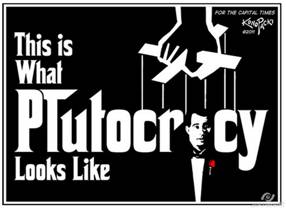Sep 28
20110
Avaaz, The International Campaign to Destabilize Bolivia
Avaaz Bolivia Corporate Media Coup Imperialism Morales Non-profit Industrial Complex Rockefeller
International Communiqué Wednesday September 28th, 2011 Regarding letter to Morales on TIPNIS dispute
The following communiqué was issued on Wednesday September 28th, 2011 in response to a post sent to an International Climate Justice list on Sunday, September 24th, 2011 and another (below) on Tuesday September 27th, 2011. Where no authorization by contributors has been approved, names and list identities have been removed. Where contributors have authorized their views be made public, names are identified. -admin
From: Cory Morningstar
Sent: Wednesday, September 28, 2011 10:31 AM
To: (removed)
Cc: (removed); (removed)
Subject: RE: FW: [removed] FW: Regarding letter to Morales on TIPNIS dispute
This will be my last response to this communication.
You stated previously:
"To not hold him to the same standard we hold elected officials to everywhere is to do him and our climate justice movement a disservice."
Of course. Yet there are observations to be made in regards to this statement. Questions that arise include: where was the Avaaz campaign/petition against Harper after the massive violence/mass arrests against the G20 protesters in Toronto by the state police – under the Harper regime? This state violence represented the greatest violation of civil rights in recent Canadian history. Where is the Avaaz petition against the Obama regime for the violence by state police happening right now on Wall Street? The cops are gassing the shit out of them too. The list goes on & on & on. If Avaaz campaigned on these – I did not see it being circulated.
You stated:
"However, it appears that, as a result of the letters–those signed by groups inside and outside of Bolivia, who knew that violence by the police against the marchers was pending–Morales has suspended his support for the project. I wish the letters had had this affect before the violence played itself out, but one of the reasons for the letters was to try to prevent this from escalating the way it did, which only Morales could do"
Was Morales’ about-face on the project a result of the Avaaz and Amazon Watch petitions? Was it a result of media coverage of the violence that ensued? Was it a result of his own government officials protesting and resigning? Was it a result of letters like the attached, clearly demarcating appropriate places to build roads, couching their criticism in cautious frames?
We may never know. But it seems all of these voices in support of the protesters are having an effect."
Yet, before this violence on the protesters occurred, it was reported that the issue was going to the Bolivian people to decide by way of a referendum. (I wish we had these in Canada)
Also:
"As protesters began to make their way to La Paz, at least nine attempts at dialogue were made by the government to try and resolve the demands of the marchers." (http://www.greenleft.org.au/node/48959)
Morales has been painted as an evil villain to the world, along with most other leaders who ever attempted / attempt to keep their resources for their own people such as Chavez, Castro, – and many more who have been toppled or assassinated by the US.
Much damage has been done in many ways. Divisions have been created which will no doubt be preyed upon and capitalized upon by US interests/influences. Perhaps it stopped escalating not because of letters, but only because Morales is completely familiar with how liberating countries are successfully toppled by US power/interference. Perhaps he stopped everything in its tracks because he recognized what was happening and recognized that his people – and outside people – were successfully being manipulated. I’m not saying this is what happened – I’m saying we cannot underestimate US interference.
Let us not fall into a trap that will only serve to further hurt and destroy the very people we wish to support.
How many times do we see this happening: The crazy dictator is carrying out violence on his own people! The people must be saved from the tyrant! Don’t worry good citizens – the west will save you! Democracy and liberation are coming your way! The colonizers will save you! (only if you have resources we can steal). It’s the same story over and over again. And why not? The world seems to fall for it over & over again. Weeks or months later the truth will slowly begin to reveal itself. Who was involved. When it was planned, how people were coerced or manipulated, etc. etc. And of course this information is rarely/never put out by corporate media – an integral part of the Imperialist death machine. Of course by then it is too late, while the bombs are being dropped on the civilians, everyone goes back to catching up on facebook and drinking their lattes.
(removed)’s message this morning, confirms once again, – we must be so incredibly cautious with countries the Imperialist powers have set their sights on.
Important questions arise regarding the Bolivian Indigenous groups demanding REDD. Who/what organizations specifically, are teaching/convincing these Indigenous groups that REDD would be good for them? This is a critical question that needs an answer. http://climate-connections.org/2011/09/23/blog-post-from-the-belly-of-the-beast-in-the-bowels-of-the-world-bank/
You state:
"Destabilization by US AID or other foreign actors is, in my mind, a separate and equally important issue. We all must hold our own governments to account for efforts to destabilize other governments.
But silence is, in my mind, unacceptable in the face of violence. And if destabilization is a concern, as it should be, then violence against one’s own citizens should be condemned."
I strongly disagree that destabilization by US AID, etc. is a separate issue. It is very possible – if not likely – that this was the very root of what has just transpired. To believe that funding of NGOs and institutions are separate to such crises is, in my opinion, both naive and very dangerous. History shows us clearly that the forces we seek to resist constantly absorb opposition, through compromised NGOs and other means. All means. Every means. If we are not understanding by now how Imperialism and Colonialism conquer, we are not doing our homework. To simply dismiss the funding ties and the partnerships with powerful foreign interests, REDD advocates, etc. is dangerous denial.
The author is suggesting that destabilization (by US powers) must be considered a likely possibility in what just happened. No one was suggesting silence on the issue. Rather – urgent mediation. People were urging dialogue with all groups involved and the government rather than infusing the crisis which could have easily resulted in aiding and abetting an internal war, which, as we see repeatedly, gives Imperialist states the excuse to go in and overthrow countries rich in resources. Surely silence in this respect, on this very possibility, must be considered offensive and insulting to all Indigenous Peoples.
Regarding the need to necessity to condemn violence. Ultimately, the individuals and organizations on this list (& those who signed the petitions) need to come to recognize, once and for all, that the violence is all around us.
Ironically, we condemn violence as we participate in it daily.
The violence everyone claims to be against is inherently built into the global industrialized economic system. Until we dismantle this system, the violence upon our Earth and against those most vulnerable will never stop. We all have blood on our hands. If you support the industrialized capitalist system / or ‘green’ capitalism, then you actually do support such violence. The global economic system is violence that must be condemned rather than celebrated and worshipped. The imperative to dismantle the unjust violent economic system should be the key element within the platform/mandate of [removed].
Instead we talk about ‘green’ capitalism, fair-trade diamonds, electric cars, etc. ignoring the massive inequalities we no longer even seem to see. The wealthy 15% creating 85% of the emissions expects to live this way – while everyone else is expected to clamour for the scraps. Does anyone really believe there is anyone on this planet who actually wants to mine or the other horrible jobs that kill you by the time you are 40 – all to supply the wealthy with their wants?
And now, upon reflection over the past few days, I would like to point out some major hypocrisies that I find very unsettling. Is it right that privileged people feel they can tell people with no road – that they should not have a road (or anything else for that matter) when they themselves drive & fly anywhere they want, anytime they want with full access to anything they need or want.
We have approximately 12 of the 64 groups opposed to the road – 52 in favour (from what I have read). Many Indigenous people in support of the road were quoted as saying they wished for access to basic essential services like medicine/hospitals and that the road would provide this.
It feels like this: "Don’t touch any of that rainforest because I have a reality tour booked there for my next annual vacation!" or "Since we’ve destroyed that majority of the world’s forests through our own insatiable consumption and an economic model that destroys most everything (while exploiting your people and our shared planet) don’t touch the forests that we cannot personally access – especially if it is for your gain and not ours."
Then the Avaaz signers & all the others who are outraged run out to Home Depot and buy a new FSC (scam) picnic table on sale for 99.00 because last year’s doesn’t really look that good anymore.
Question: Why have all the organizations that have never had anything to do with the People’s Agreement, all of a sudden become so interested in the rights of the Indigenous of Bolivia? If they are so interested – would they not endorse the People’s agreement and work like mad promoting it? Will they do this now?
And let’s not forget – it’s ok to cut down your Amazon in order to provide meat to the rich countries – but don’t worry – we won’t bring that up. And even if we do bring it up, we still won’t work towards ending the industrial livestock industry. (because we are not prepared to educate nor campaign on the necessity to slow down meat consumption in wealthy countries – we polled on this question and the public did not like it! – bad for the brand! Bad for funding!)
Who does everyone think is eating all the soybeans grown in Bolivia? Of course it all for the wealthy countries. But the soybeans are not enough. We are taking all the quinoa too. (Tough luck if the Bolivian people no longer have their staple food.)
So, wealthy countries won’t slow down on our own consumption/growth but we expect/demand struggling countries like Bolivia to stop production/export – when they are made purposely poor at the hands of the industrialized global capitalist system.
A final note – Sandy states (message inserted below): "As an indigenous man who was in Cochabamba I have to say I did not that there was accusations that some indigenous voices were excluded and noted it with concern but then I also noted that all the big NGOs were there were more concerned with getting their own advocates (usually non indigenos0 to the meeting than in funding any indigenous voices from around the world to attend. The Pacific in particular fdared really badly in this respect."
This has been brought up many times on the list. Why is there never any response? Why is it always the same people (usually those who have access to funding) that attend these meetings?
Lastly – yes – it was absolutely shitty and unjust that the group in Cochabamba was excluded.









